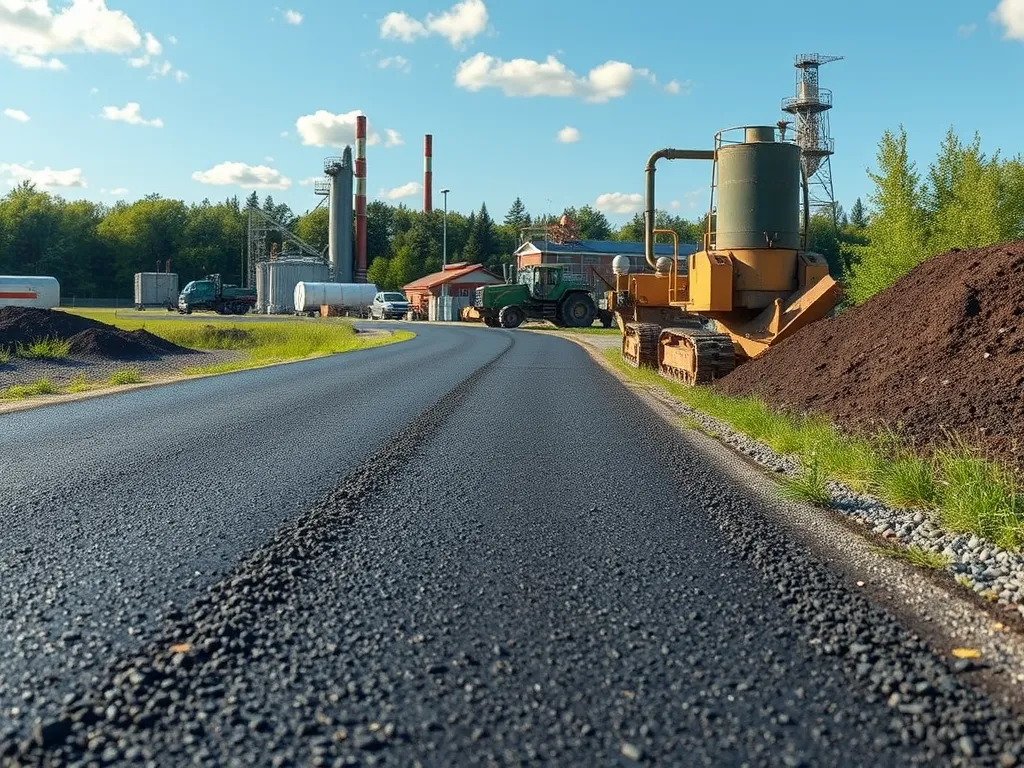Economic Impact Of Asphalt Infrastructure
Published on: November 24, 2025 | Last Updated: April 14, 2025
Written By: George Voss
The economic impact of asphalt infrastructure refers to how roads and pavements boost economies through job creation, cost savings, and efficient transportation. Asphalt roads cost 20-30% less to build than concrete, require minimal maintenance for 15-20 years, and support over 300,000 U.S. jobs. These factors make asphalt the top choice for 94% of paved U.S. roads due to its balance of affordability and performance.
This article breaks down asphalt’s role in economic growth. We’ll explore how local road projects create jobs, why asphalt overlays save up to 40% versus full reconstruction, and how smooth pavement cuts vehicle operating costs by 4-7%. You’ll also see data on trade efficiency gains, tourism revenue boosts from better roads, and how recycled asphalt (RAP) reduces material costs by 25%. Technical concepts like lifecycle cost analysis (evaluating total costs over decades) and PG binder grades (asphalt durability ratings) are explained in plain terms.
Contents
- Understanding Asphalt Infrastructure
- Direct Economic Benefits Of Asphalt Infrastructure
- Long-term Economic Advantages Of Asphalt Roads
- Asphalt Infrastructure and Market Accessibility
- Measuring the Economic Impact Of Asphalt Infrastructure
- Environmental Considerations Of Asphalt Infrastructure
- FAQ: Economic Impact Of Asphalt Infrastructure
- Closing Thoughts
- Useful References for You:
Understanding Asphalt Infrastructure
Asphalt forms the base of roads, lots, and paths we use daily. Built to last, it links people, goods, and services across cities and states.
What is Asphalt Infrastructure?
Asphalt roads use layers of stone, sand, and bitumen. Bitumen acts as glue. This mix hardens into smooth, safe surfaces for cars and trucks. Over 94% of U.S. paved roads rely on asphalt due to its quick setup and low cost.
Key Components of Asphalt Roads and Pavements
Three main parts make up asphalt roads:
- Aggregates: Crushed stone (95% of mix) gives strength.
- Binder: Bitumen (5%) binds materials.
- Additives: Polymers or recycled rubber boost flexibility.
New tech like warm-mix asphalt cuts fuel use by 20% during paving.
Role Of Asphalt in Modern Transportation Systems
Smooth asphalt roads let trucks move goods faster. Less wear on vehicles saves $1,200 per driver yearly. Roads with high-speed limits (55-75 mph) boost trade by linking ports, farms, and factories. Poor roads cost U.S. drivers $130 billion a year in repairs and fuel waste. Asphalt’s quick fixes keep traffic flowing, saving time and cash.
Next, we’ll break down how asphalt projects create jobs and cut costs for towns and states.
Direct Economic Benefits Of Asphalt Infrastructure
Asphalt infrastructure drives immediate financial gains through labor markets and construction budgets. Let’s break down its direct contributions.
Job Creation in Asphalt Production and Construction
The asphalt industry supports over 300,000 jobs nationwide. From plant operators mixing PG (Performance-Graded) binders to paving crews laying down Superpave-designed mixes, each mile of road requires skilled labor. Projects funded by programs like the Infrastructure Investment and Jobs Act further amplify demand for workers.
Local Employment Opportunities in Road Projects
Road construction prioritizes local hiring. A typical 2-lane asphalt highway project employs 15-20 workers per mile, with 70% sourced from nearby communities. This injects wages directly into regional economies, boosting spending at local businesses.
Cost-efficiency Of Asphalt Road Construction
Asphalt roads cost $2-$5 per square foot for initial installation—30-50% less than concrete. Fast curing times (often 24-48 hours) minimize traffic disruptions, saving $1,500 daily in lost productivity per lane closure.
Reduced Initial Capital Costs Compared to Alternatives
Material availability plays a role. Over 94% of U.S. roads employ asphalt due to lower raw material expenses. Hot-mix asphalt plants operate within 50 miles of most projects, cutting transport fees by 18-22% versus importing concrete or composites.
Looking beyond upfront savings, asphalt’s lifecycle performance shapes long-term fiscal outcomes. Next, we’ll explore how durability and maintenance strategies amplify these benefits.

Long-term Economic Advantages Of Asphalt Roads
Asphalt roads deliver sustained value beyond the initial build phase. Their design balances upfront affordability with decades of performance, creating a ripple effect across local and national economies.
Durability and Reduced Maintenance Costs
Modern asphalt mixes use PG (Performance Graded) binders tested under the Superpave system to withstand temperature extremes. These advanced materials resist cracking and rutting for 15-20 years before major repairs. With fewer full-depth failures, agencies spend 18-22% less on recurring fixes compared to rigid pavements.
Economic Impact of Asphalt’s Shorter Repair Times
Pothole patching or surface milling takes 30% less time than concrete slab replacement. Faster repairs cut lane closure durations by up to 50%, reducing traffic delays that cost commuters $1,200 per hour on average. Projects like Interstate 85 in Georgia saved $3.2 million in user delay costs by choosing asphalt for rapid rehabilitation.
Asphalt Overlays Vs. Full Pavement Rehabilitation
Overlays add 2-3 inches of fresh asphalt over existing pavement at $25-$50 per ton. Full rebuilds require tearing out old layers, costing $80-$120 per ton. For roads with stable bases, overlays slash project budgets by 40-60% while restoring smoothness and extending service life by 8-12 years.
Cost-Benefit Analysis of Maintenance Strategies
A 2023 FHWA study found asphalt overlays provide a 3:1 return over 20 years versus full-depth reconstruction. States like Texas allocate 70% of road funds to preservation methods like chip seals and thin overlays, cutting lifecycle expenses by $4.8 billion annually. Strategic maintenance keeps 92% of road networks in “good” condition without massive capital outlays.
These fiscal efficiencies set the stage for exploring how robust asphalt networks bolster market access and trade growth.
Also See: Benefits Of Investing in Quality Asphalt Tools
Asphalt Infrastructure and Market Accessibility
Road networks built with asphalt directly shape how communities access goods, services, and opportunities. Smooth, durable surfaces enable faster movement of people and products, creating ripple effects across regional economies.
Enhancing Trade Through Reliable Road Networks
Asphalt roads form the backbone of freight transportation. Over 70% of U.S. goods move by truck, relying on pavements designed to handle heavy axle loads. PG (Performance-Graded) binders in asphalt mixes ensure roads withstand temperature swings and traffic stress, minimizing unplanned closures. This reliability keeps supply chains fluid, supporting just-in-time delivery systems critical for industries like manufacturing and retail.
Reduced Transportation Costs for Goods and Services
Every 10% reduction in road roughness cuts vehicle operating costs by 4.5%, per the World Bank. Asphalt’s smooth surfaces lower fuel use by 2-5% compared to rougher pavements, saving fleets up to $1,200 annually per truck. For agricultural sectors, asphalt roads slash post-harvest losses by 15-20% by enabling faster transit of perishables to markets.
Supporting Tourism and Local Businesses
Well-maintained asphalt roads boost tourism revenue by 25-35% in rural areas, according to Federal Highway Administration data. Scenic byways with asphalt pavements attract road trippers, while smoother rides increase visitor satisfaction. Local businesses gain too: 82% of consumers travel over 15 minutes by car to reach stores, relying on asphalt roads for predictable commute times. Restaurants, gas stations, and shops clustered along asphalt corridors report 12-18% higher sales than those on gravel routes.
These economic threads set the stage for quantifying asphalt’s full value. Next, we’ll examine metrics like lifecycle costs and user savings that shape investment decisions.

Measuring the Economic Impact Of Asphalt Infrastructure
Road planners use data-driven tools to track how asphalt roads boost the economy. These metrics show savings, job growth, and trade gains tied to pavement quality and build choices.
Key Metrics for Evaluating Asphalt’s Economic Value
Three factors shape asphalt’s role in economic health: build costs, road life, and user savings. Each metric links to jobs, trade flow, and cash flow for towns and states.
Service Life and Lifecycle Cost Analysis
Asphalt roads last 15-20 years with low upkeep. Lifecycle cost studies prove they cost 30% less than concrete over 30 years. Warm-mix tech cuts build temps by 50°F, saving $1.50 per ton in fuel. Recycled asphalt (RAP) use hits 99%, slashing material costs by 40% per mile.
- 20% longer road life vs. older pavements
- $8,000 per lane-mile saved via RAP reuse
- 2-3 day road fixes vs. 7+ days for full rebuilds
User Cost Reductions from Smooth Pavement Surfaces
Smooth asphalt cuts driver costs. Rough roads hike fuel use by 4.5% and tire wear by 22%. Well-kept asphalt saves $800 per car yearly. Faster truck trips trim freight costs by 12%, aiding local trade.
- 1.2 billion gallons of fuel saved yearly from U.S. pavement fixes
- 4% boost in retail sales near upgraded roads
- 15% drop in cargo delays on asphalt vs. cracked roads
These gains set the stage for greener gains. Next, we explore how asphalt reuse cuts waste and lifts eco-friendly growth.
Environmental Considerations Of Asphalt Infrastructure
Asphalt infrastructure balances environmental responsibility with economic performance. Its recyclability and efficient use of materials directly influence long-term financial outcomes for communities and contractors.
Recyclability and Resource Efficiency
Asphalt stands as the most recycled material in the U.S., with over 95% of reclaimed asphalt pavement (RAP) reused in new projects. RAP combines crushed old pavement with fresh aggregates and liquid asphalt binder. This process preserves finite resources like aggregates and bitumen while cutting landfill fees by $1.50–$3.00 per ton of waste diverted.
Economic Benefits of Recycled Asphalt Materials
Using RAP slashes material costs by 20–30% per ton compared to virgin mixes. Contractors save $8–$12 per ton on hot-mix asphalt production when blending 25% RAP. These savings scale rapidly: repaving a 1-mile road with recycled materials can reduce expenses by $15,000–$30,000. Recycling also supports 50,000+ U.S. jobs in asphalt reclaiming and processing facilities.
| Material | Cost per Ton | CO2 Emissions (kg/ton) |
|---|---|---|
| Virgin Asphalt | $65–$85 | 12–15 |
| 30% RAP Blend | $48–$68 | 8–10 |
Lifecycle cost analyses show recycled asphalt pavements last 15–20 years with 40% lower maintenance costs. Reduced energy use during production—RAP requires 30% less heating—adds another $2–$4 in savings per ton. States like California and Texas report $120 million annually in avoided disposal costs through asphalt recycling programs.
Up next: Quantifying these advantages requires precise metrics. Let’s explore how experts measure asphalt’s full economic value.

FAQ: Economic Impact Of Asphalt Infrastructure
What Are the Economic Benefits Of Asphalt Roads?
Asphalt roads provide significant economic benefits by reducing construction costs, lowering maintenance expenses, and enhancing job creation. They are often 20-30% less expensive to build than concrete roads and require less frequent repairs, which translates into long-term savings for municipalities and taxpayers.
How Does Asphalt Infrastructure Improve Transportation Efficiency?
Asphalt infrastructure enhances transportation efficiency by providing smoother surfaces, which reduce vehicle operating costs and travel times. Well-maintained asphalt roads facilitate better freight movement and lower fuel consumption, creating a more effective transportation network that supports economic growth.
Why is Asphalt the Preferred Material for Road Construction?
Asphalt is preferred for road construction due to its cost-effectiveness, durability, and ease of maintenance. Its quick installation and lower initial costs compared to concrete make it an attractive option for municipalities aiming to optimize transportation infrastructure budgets. Additionally, asphalt’s recyclability contributes to its sustainability and economic advantages.
Closing Thoughts
Asphalt infrastructure plays a vital role in boosting economic growth. Its contributions range from job creation in production and construction to long-term savings through durability and reduced maintenance. The cost-effectiveness of asphalt not only benefits construction budgets but also enhances market accessibility, driving trade efficiency across regions.
Additionally, the recyclability of asphalt materials presents significant environmental benefits, helping to conserve resources while maintaining economic viability. As communities continue to invest in asphalt infrastructure, the positive impacts on local economies are clear.
For more detailed information and tools regarding asphalt, visit Asphalt Calculator USA.
Useful References for You:
- Comparative environmental and economic assessment of a road pavement containing multiple sustainable materials and technologies – ScienceDirect
- Global Asphalt Paving Industry Statistics: Growth Projections and Economic Impact – WiFiTalents
- Asphalt Manufacturing in the US – Market Research Report (2015-2030)
- Understanding Asphalt Surfaces and Their Environmental Impact | Ecoraster North America


